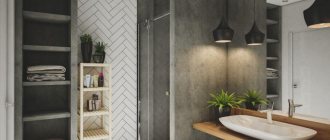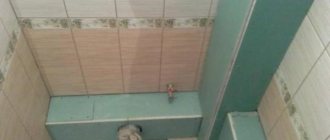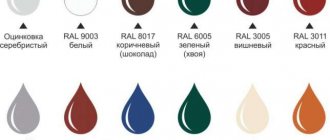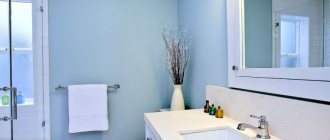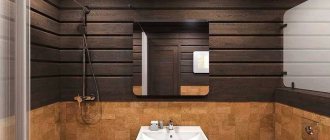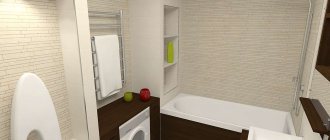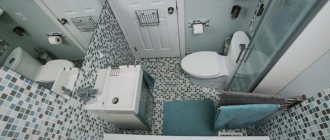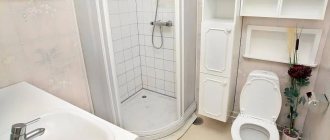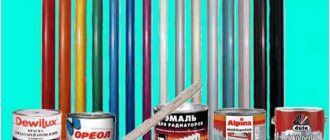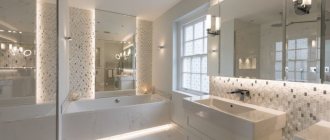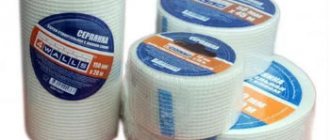If in the kitchen water and sewer pipes are usually hidden under the sink cabinet, then in the bathroom other methods are used to hide them. More often than others, you have to hide the riser along with the sewerage, cold and hot water pipelines; for these purposes, a box for pipes in the bathroom is made from different materials.
Before installing the box, several options for its manufacture are considered based on the criteria of aesthetics, cost, and compactness. For the construction of the structure, they mainly use building materials used in the construction of walls and partitions; it is useful for any consumer to know their main types and installation methods.
Rice. 1 Options for the location of open pipes in the bathroom
Material requirements
If you decide to hide pipes, the material must be chosen at the planning stage, and you must be guided not only by its aesthetic qualities. The bathroom is a wet room, that is, a room with water supply and wet processes. Here, temperature and humidity change periodically, so materials for the box are selected based on the following characteristics:
- Moisture resistance. A basic requirement for any materials intended for use in the bathroom. The design of the box should not be deformed in an environment of elevated temperatures and aggressive household chemicals, and the surface should not absorb water.
- Corrosion resistance. Condensation often accumulates on the pipes, and warm steam fills the entire volume of the room. The frame and fasteners of the structure should also not be afraid of moisture and elevated temperatures.
- Decorative. The correct design fits into the design of the room and matches the rest of the decoration. Since most often the walls are finished with tiles, choose a material suitable for cladding.
Decorating a box with tiles Source o-vannoy.ru
- Compact, ergonomic. Bathrooms rarely boast dimensions. The less space the structure takes up, the more convenient it is to use, and this directly depends on the material of the frame and the walls of the box. A metal profile or wooden slats are used for the frame.
- Budgeting. Not only the cost of the material is important, but also the possibility of self-installation. Inviting specialists results in higher repair costs.
- During operation, the following requirements are imposed on the box:
- Strength, wear resistance. Resistance to mechanical loads is important, especially if the structure has moving parts.
- Easy care. Cleaning the surface from dirt should not take much time. A good material is one that can withstand standard (household) cleaning agents.
- Environmental friendliness. For installation, materials are selected that will not emit substances toxic to health. The outer layer of the finish must be sufficiently resistant to mold.
- Access to content. A wise decision would be to provide a small hatch that provides access to fittings and metering devices.
And no pipes Source knaufmag.pl
See also: Catalog of companies that specialize in redevelopment of country houses of any complexity
Advantages of hiding communications under a box
When decorating bathrooms, boxes are now often used to hide several or all pipes. Such elements not only allow you to create a beautiful design, but also have a number of advantages.
These include:
- Attractive appearance. When made from high-quality materials, a cabinet for masking pipes will not stand out against the general background or spoil the interior.
- Easy to assemble. The structure can be assembled not only at the rough finishing stage. Often pipes are sewn up during a bathroom refurbishment. Frame and sheathing elements can be installed on top of the cladding.
- Possibility of pipeline maintenance or repair. If the box is equipped with a hatch, you can find out the readings of metering devices and monitor the condition of the pipes. If necessary, water supply or sewerage elements are replaced.
- Possibility of combination with shelves, installations and other interior details. This allows you to effectively use the space of a small bathroom.
Why don't builders hide pipes?
The bathroom is rich in all kinds of communications. Sewage pipes, hot and cold water supply, as well as additions in the form of a heated towel rail or heating system are on public display here.
This “openness” is not accidental. Even if the room is spacious enough and the layout allows, builders leave most of the pipes in sight. The reason lies in building codes that directly prohibit the hidden installation of pipes connected by certain types of fittings. For such devices, easy access in case of problems occurs.
Another reason for open installation is the formation of condensation on metal pipes with cold water. Only air constantly circulating around the pipe can effectively remove condensate.
That is why in the bathroom you can see pipes anywhere on the wall, in a corner or in a niche. They can be vertical or horizontal, running under the ceiling or near the floor. A separate class of pipes that need to be hidden are products of different diameters coming from plumbing equipment, as well as toilets with installation.
Not every pipe needs to be hidden Source izhevsk.ru
How to hide communications?
The wiring in the bathroom includes pipes connected to various plumbing fixtures (bathtub, washbasin, and with a combined bathroom, to the toilet), as well as various devices and devices: valves, filters, water meters.
To prevent communication systems from being conspicuous, they are hidden using various methods.
When organizing hidden wiring, the pipes are hidden in specially cut channels in the walls. Please note that this method has many limitations.
One of them is hidden wiring. In this case, the pipes are hidden inside the walls, arranging special grooves in the latter.
True, this method is not universal, since it has a number of limitations:
- wall gating can only be carried out during a major overhaul, since in this case the complete elimination of finishing coatings and replacement of communication equipment is required;
- when installing hidden wiring, it is impossible to hide a filter, meter or other device;
- building regulations prohibit punching grooves in load-bearing structures, since they sharply reduce the strength of the walls;
- there are restrictions on the dimensional characteristics of pipes that are used for hidden wiring: their diameter should not exceed 50 mm. Therefore, this method is in no way suitable for masking a thick sewer pipe;
- This method is not suitable for risers, the appearance of which is unlikely to decorate the bathroom interior.
An alternative to hidden wiring is a combined system that involves installing a box on the surface of the walls. In this case, the pipes are placed in a specially allocated space, and the outer walls are finished in accordance with the style of the interior.
Types of designs
There are many ways to disguise unsightly communications. Making a box that simultaneously performs a protective and decorative function is the most sound solution. The task is implemented in different ways; The most common configurations are:
- In the form of a cabinet. It is chosen if it is necessary to hide a riser or other vertical system and leave free access to communications. Shelves help to rationally use the interior space.
- In the form of a partition. A convenient option for a large bathroom, all communications of which are located on one wall; Also suitable for wall-hung toilets. The pipes are separated by a wall-sized partition; The area of the room is slightly reduced. The bathroom looks neat, and behind the partition there is enough space to organize the storage of a variety of things.
- In a compact design. The box is constructed directly around the pipes. This option is used more often than others, as it does not clutter up the space, looks neat and is quickly made. Suitable for all types of systems, including those adjacent to the ceiling (floor).
Corner design with inspection hatch Source cleanipedia.com
Advice from professionals
Plumbers and builders give the following recommendations for masking pipes:
- When hiding the risers, markings begin from the floor.
- Installing a door or forming an inspection hole is mandatory.
- Any material used for cladding is impregnated with an antifungal solution. This will prevent mold from forming.
- Wooden structures are not recommended for installation in the bathroom. This frame is suitable for a toilet.
- The cabinet for pipes cannot be assembled from chipboard, which absorbs moisture. The material swells and begins to crumble.
- Vertical parts are installed at a distance of no more than 30 cm. This gives the structure rigidity.
- Closely located pipes are not sutured separately. It is recommended to build a single structure.
The walls should not come into contact with communications. The minimum distance is 3 cm.
Installation features
Before starting work, check the condition of the pipes. The main attention is paid to connections, especially if they are threaded; detected defects are eliminated.
Then the dimensions of the future structure are measured, taking into account that the distance between the pipes and the walls of the box cannot be made less than 3 cm. The pipe box is installed in the following sequence:
- A metal profile (wooden slats) is fixed to the walls. If wooden blocks are used, they are treated with a moisture-repellent compound.
- The front face stand is mounted.
- The metal structure is attached to the floor and ceiling. If the frame is high (exceeds 1.5 m), additional horizontal lintels are provided.
- The selected material is cut to size. The parts are secured to the frame with small self-tapping screws.
- It is highly desirable that the box has a technical hole for a hatch. If a leak occurs, you can easily fix it.
- If necessary, finishing work is carried out. Drywall, MDF and plywood can be painted or tiled. Plastic panels are beautiful in themselves and do not need additional finishing.
Making the frame Source design-homes.ru
Plasterboard box in the bathroom
Let's start with drywall, as a more popular and versatile option. Working with this material is a pleasure. It is easy to process and allows you to assemble structures of almost any configuration.
Tools
To work we need the following set of tools:
Table 1. Tools for work.
| Tool, photo: | Description, purpose: |
| Drywall is attached to a frame, which in turn is attached to the walls, floor and ceiling. The connection is made using dowel screws or anchor wedges, which are inserted into holes made in concrete and brick walls with a hammer drill. The tool itself does not require a professional, since the amount of work will not be very large. |
| A screwdriver will help us connect frame parts to each other, secure plasterboard sheets, screw screws into dowels when attaching profiles, and even completely replace a hammer drill if the work is done in a wooden house. It is better to choose a cordless tool, as it is especially convenient to work with at heights. It must have a high engine speed in order to quickly and effortlessly screw hardware into a metal profile. |
| This profile will have to be cut to the size of the box. Professionals on large objects do this with an electric tool, but for us, metal scissors will be enough, since there will not be so many components. |
| When cutting drywall, uneven edges are obtained, which can protrude beyond the plane of the box and interfere with the laying of tiles in the future. The easiest way to correct the situation is with a rasp like this, which can be purchased for no more than 100 rubles. |
| You can cut drywall very easily and quickly with a utility knife. It is used only for straight cuts. For a curly one, you will additionally need a hacksaw. |
| You will need a tape measure and a marker. For the drywall itself, you can also use a pencil - it is not suitable for profiles, since it will not draw on a galvanized coating. |
| It is very important to set the frame strictly level, as it can serve as an excellent basis for supporting wall tiles during finishing. To determine the horizon, it is best to use a water level or a laser level. As a last resort, we use a bubble level, but be careful, as it may cause an error in measurements. |
Prices for popular hammer drill models
Hammers
Of course, we did not name the entire set, since the need for various small things constantly arises. For example, dowel-screws can be hammered in rather than tightened, in which case a hammer will be useful, or profiles can be connected with a cutter, and so on. If we missed something important, it will emerge as we describe the work.
Materials for work
The easiest way to assemble a box is from the following components:
Table 2. Material for work.
| Materials, photos: | Description: |
| There are many varieties of profiles, but the most convenient for our purposes is the ceiling 27*28 mm. It has a U-shape without stiffeners. The strength of the element will depend entirely on the thickness of the metal - it is best to take the 0.6 mm option. |
| We will only use moisture-resistant drywall. It has a green shell color. Both wall and ceiling options are suitable, since the structure will subsequently be reinforced with ceramic tiles glued on top. |
| Plastic dowel screws will securely connect the frame and walls. Buy the version with a mushroom cap. The photo shows a secret one - it can also be used, but the first option will hold better. Fastener dimensions 6*40 mm. The same type of drill is used for the hammer drill. |
| These 9 mm shorts are used to connect the profiles together. You can replace them with a model with a press washer, but screwing them into the metal is somewhat harder. |
| You can tell the salesperson in the store about self-tapping screws for drywall, and he will show you such hardened hardware with rapid threads. Due to this, they are held qualitatively on thin-walled profiles. This fastener is used for installing plasterboard sheets. A length of 25 mm will be sufficient. |
Prices for drywall and sheet materials
Drywall and sheet materials
Now let's say a few words about how to calculate the amount of material. It is clear that we will not calculate the fasteners individually, so we take them “by eye”, with a small margin - they are inexpensive and will always come in handy when necessary on the farm.
Most likely, one sheet of drywall will be enough if the length of the pipes is not very long. In general, the sheet has dimensions of 120*250 cm . Use this data in your calculations.
The profile is also easy to calculate. You need to measure the length of the future box. Let's say it turns out to be 2.5 m . We multiply this number by three, since there will be three belts. In our case it turns out 7.5 m . The length of one profile is 3 m , which means we need to buy 3 pieces - the trimmings will be used to form stops on the sides. To do this you need to know the depth and width of the box.
Advice! If the sides of the box are close to 50 cm , then it is better to install additional jumpers from the PN 27*60 for reliability. We also increase the number of belts to 4 .
The last point that is worth calculating is the perimeter of the inspection hatch. It will also have a rigid base. You will see everything in detail further.
Having trouble making the box? More detailed information in our special article! All about the types of boxes, the pros and cons of designs. Also detailed instructions on making a frame and installing drywall.
Assembling a plasterboard box for pipes
Riser - sewer and water pipes
So, before us is an ordinary bathroom of a high-rise building, through which a sewer riser and water pipes pass. We are required to cover it all up nicely and leave access to the audit and water meters. We will act in the following order:
Step 1. Marking the contour of the box.
Marking the contours of the box
- Everything, as usual, starts with markings. For this we need a plumb line, a pencil, a dye thread, a square and a tape measure (not always).
- We find the most protruding parts on the pipes. This could be connections, taps, meters, sewer inspections, and so on. Using a square, we transfer their level with marks to the walls. Then we add 3 cm to the sides from the riser to the points. As you understand, we are now marking both planes at once. If some obstacles prevent you from making the required indentation, then attach the PNP profile and see its most optimal position, taking into account the thickness of the drywall used and the tiles that will then lie on it - 2.5 cm , so as not to make a mistake.
- Then we take a plumb line or laser level and place marks at the bottom and top of the wall, focusing on the marks obtained taking into account 3 cm . Using a dye thread, we connect the dots and get a straight line from the ceiling to the floor.
- Next you need to mark the ceiling. This part is the hardest. We apply a square to the walls one by one and draw two intersecting lines. What's so complicated about that, you ask? And the fact is that next we need to check the angles that we got. Naturally, the walls will be exactly 90 degrees . We check the outer corner, which ideally should be the same. For this we use the same square or protractor. If large differences are detected, the lines should be redrawn so that the least noticeable difference is obtained.
The floor can be marked after attaching the guides to the walls and ceiling
- Next, we take a plumb line and apply it with a thread to the point of intersection of the lines in order to project it onto the floor. This work can be done with a laser level, but a bubble level can deceive. This is the only way we do it. It is impossible to measure separately using a square and a tape measure, since in the end the outer corner may turn out to be blocked.
- Having found the desired point, we connect it with the lines on the walls.
Step 2. Profile installation.
We mount the profiles
- Using metal scissors, we cut two profiles slightly less than the height of the room so that we do not run into the ceiling when installing them. We take a hammer drill in our hands, align the outer edge of the profile along the line on the wall and carefully begin to drill, trying not to move anything. You should start from the ceiling, retreating 50 centimeters from it . Then insert the dowel screw into the resulting hole and tighten it.
- We go to the bottom and repeat the procedure exactly. We make sure that the profile is exactly along the line, after which we begin to fasten it along the entire length, in increments of 40-50 cm .
- We attach two sections of the profile, as shown in the photo, to the floor and ceiling.
Advice! Even the shortest profile must be secured with at least 2 dowel screws so that it does not rotate.
Life hack from the master
In situations where the crossbars need to be attached to the guides in a hard-to-reach place, it is better to install them immediately, and only then attach the profile to the wall.
Step 3. Installation of the corner post.
Installing a corner post
- Next you need to secure the corner post. This is not difficult to do, but it is worth remembering that the element can bend for various reasons, so before fixing it, be sure to check its position according to the level.
- The installed stand will dangle as it is practically not secured. Start installing crossbars, and this effect will gradually fade away. Jumpers are installed in increments of 60 cm . The exception is the installation location of the inspection hatch - there we focus on its position and dimensions, and the place where the drywall sheets are joined.
- The crossbars are connected using self-tapping screws. On the side where it is not possible to insert a profile, mounting tabs are made on the parts, or you can attach another profile to the corner post, which needs to be turned towards the second wall.
Jumpers on the second side of the frame
If your box is small in size, then you don’t need to install jumpers. They will be replaced by drywall itself, screwed on both sides. The inspection window edging is also attached only to the drywall.
Step 4 . Fastening drywall.
We fix the drywall
- At the last stage, we cut the drywall into strips of the required width and attach it to the frame. The easiest way to cut is this way. We attach the sheet to the frame and grab it at several points, lifting it from the floor by 5 mm . We take a stationery knife and cut through a layer of cardboard along the corner post, as if along a guide. We break the sheet and bend it. We cut the paper on the other side and remove the excess piece.
- We clean up any unevenness on the edge with a utility knife or rasp.
- The first side that we will sew up will be the one where the hole for the hatch will be. We also cut it in place with a saw, and feel free to close the box completely. Self-tapping screws must be screwed into guide profiles and jumpers; their pitch is 20-25 cm . In this case, there is no need to monitor the caps that are precisely sunk into the material, since the tiles are installed on glue, which is not afraid of such small errors.
Prices for metal profiles
Metal profile
This completes the installation, all that remains is the finishing, which you can read about in other articles on our website.
Using a box to hide a pipeline
Video - How to make a plasterboard box for pipes
Installation of a plastic box
Plastic is even easier to install than drywall
PVC is good because it is not afraid of water, and it does not require finishing, except for covering the edges. A plastic box is assembled almost exactly the same way as a plasterboard box. In principle, this material can be attached to the same metal frame.
Video - Secrets of installing a plastic box in the toilet
However, instead of metal, it is better to use a wooden strip or beam. Plastic is a fairly fragile material and any self-tapping screw that slips through the metal can damage its surface.
This is what a wooden frame looks like
Let's quickly look at the assembly process and clarify the main differences.
- So, it all starts with exactly the same markings - we need straight lines along the walls, on the ceiling and floor.
- 25 mm thick strip and nail it to the walls using 6*60 mm dowel screws.
Attention! The slats can be bent, so bend them as needed, following the markings.
Fastening the slats to the wall with dowel screws
- The same rail is mounted on the floor and ceiling.
- An external rack made of timber with a cross section of 35*35 mm or larger . It is attached to the rail using steel furniture corners.
- We also build a frame at the location of the hatch. If the box is more than 37.55 cm wide , we install crossbars.
The parts are connected with self-tapping screws and steel corners
It’s worth making a small digression here. The width is indicated with the expectation that good durable plastic that has similar dimensions can be used. If you bought a narrower version, you will need docking, which means you won’t be able to do without jumpers that go every 50 cm .
The next step is to install the start
- An L-shaped profile, or simply a starter, is cut to the length of the box, applied to the rail and attached to it with self-tapping screws or with a stapler to staples. In this case, the part is pressed against the walls so that there are no unsightly gaps.
Cutting PVC panels with a utility knife
- Then a plastic panel is taken and also cut to length. This can be done with a fine-toothed hacksaw or a utility knife. To do this, lay the panel so that the unnecessary end hangs over the edge of a plane, for example, a table or stool. Make markings with a pencil and a square. Cut through the top layer of plastic, break it and cut through the second one.
- If nothing will cover the edges of the panel (baguettes, baseboards), put a starter profile on them. Insert the plastic into the starter on the wall and attach it to the external stand with self-tapping screws. Install the second side in a similar way, having previously cut out a hole for the hatch - there is no need to refine it, since inspection hatches have their own edging that will hide the edges.
Assortment of external corners for glue
- Next, you will need an external corner profile for glue, as shown in the photo above. We will attach it with “liquid nails”. After installation, the part must be secured with masking tape and left to dry.
Prices for different types of liquid nails
Liquid Nails
This is where the work actually ends. As you can see, there is nothing complicated, it’s enough to have the right tool and know how to work with materials. We also recommend watching the videos attached to the article, where you can see another interesting variation of the plastic box.
Find out how to install a plastic wire box, and also familiarize yourself with its purpose, types, sizes, in a special article on our portal.
What to make a camouflage box from
With a successful choice of shape and material, the design of the box in the bathroom will become an organic (or, if necessary, spectacular) detail of the interior. Installation of the box is something like a small redevelopment, so the material is chosen based on the characteristics of the functioning of the pipes.
Popular materials include moisture-resistant plasterboard, PVC panels, decorative MDF board or moisture-resistant plywood. There is also an alternative to pipe insulation in the form of blinds or roller shutters.
Moisture-resistant drywall (GKLV)
There are several types of plasterboard sheets (GKL) on the market; A moisture-resistant type of material labeled GKLV is suitable for the bathroom. Sheets suitable for finishing plumbing units can be easily recognized by their characteristic green color. They are additionally impregnated with antifungal agents, which is a definite plus for wet rooms.
GKLV sheets are suitable both for creating standard rectangular shapes and for producing radius surfaces. True, to obtain a curved shape, special skills will be required.
Box with hatch made of gypsum boards Source stroyfora.ru
When choosing drywall, you must remember the following features:
- Plasterboard sheets weigh more than MDF boards or plastic panels, so installation will require more effort.
- Experts recommend additionally treating the slabs with a moisture-proofing compound. This will increase the structure’s resistance to moisture and extend its service life.
- A collapsible structure made of sheets will not work. Therefore, a hatch must be provided in the box, which will provide quick access to the meter and valves.
- If pipes with hot water (water supply or heating system) are hidden in the box, several holes are provided in the upper part of the structure. They will allow warm air to penetrate the room.
- Drywall is not a finishing material. It can be decorated with the same finish that was used for the bathroom walls, or you can choose a different material. Most often, the panels are sheathed with tiles, but other types of decoration are also used: moisture-resistant wallpaper, paint (preferably latex-based), decorative plaster.
Finishing with tiles Source berizon.ru
Plastic panels
Often the box is made of plastic panels. They have an attractive appearance and are available in a wide range of colors. You can always choose a shade that matches your bathroom design. In addition to aesthetics, plastic has the following undoubted advantages:
- The panels belong to budget finishing materials.
- They have a minimum thickness, so they do not hide the area; This is convenient for a small bathroom.
- PVC panels are waterproof and therefore easy to clean: just wipe the dirty surface with a damp cloth.
- Plastic is a durable material. It is quite flexible, durable and resistant to mechanical damage.
- Plastic panels are easy to install and, importantly, repair. The damaged part is replaced with a new one without destroying the structure.
Design of a small bathroom with hidden pipes Source assets.kemmler.de
Waterproof plywood
In the manufacture of moisture-resistant varieties of plywood, special glue is used; They are also treated with a compound that increases moisture resistance. Materials with the following markings are suitable for the bathroom:
- FC (moisture resistant). The veneers are glued with urea glue, which allows the material to be used in interior decoration.
- FSF (high moisture resistance). Resin phenol-formaldehyde glue is used in production, so the material is characterized by high water resistance. Additional advantages are mechanical strength and special wear resistance. In residential premises, material with an emission class not exceeding E1 is used.
The main disadvantage of waterproof plywood is its high cost. For this reason, it is used less frequently than other materials.
Paint or wallpaper is suitable for finishing a plywood box Source bezkovrov.com
Wood boards
Popular materials in the construction industry: particle boards (chipboards), fibreboards (fibreboard or MDF) oriented strand OSB. They are often used to create a box, focusing on the relatively low cost.
The problem is that their technical properties are not designed for continuous use in a damp room. The surface tends to absorb water vapor, so the service life of wood boards in the bathroom does not exceed 10 years. To increase durability, the surface is painted or varnished.
Both wooden beams and metal profiles are suitable for the manufacture of a supporting structure; To fix the plates, use ordinary self-tapping screws. The finished box needs further finishing. If you used a laminated MDF board, you can refuse decoration.
MDF with tile imitation Source sense-life.com
Required tools and materials
If you have already decided which box is best to hide the heating, drainage and water supply pipes, then you should start preparing tools, fasteners and materials.
To build the box you will need the following equipment:
- a well-sharpened construction knife;
- roulette;
- metal scissors;
- level or square;
- screwdriver or screwdriver;
- pencil;
- fasteners (self-tapping screws, European screws, dowels);
- drill or hammer drill.
Materials you should purchase:
- galvanized metal profiles (types ud, cd);
- silicone sealant;
- GVKL, HDF, OSB boards or plastic panels (in the latter case, it is important to choose a shade that matches the color palette of the interior);
- PVC skirting boards designed to mask joints with walls.
To prepare the plasterboard box for additional finishing, you may also need putty and corners.
Hatches
Plumbing hatches on the box provide access to equipment. Their size and number depend on the dimensions of the structure and the number of devices being serviced. Based on the method of opening, hatches can be classified as those that swing open, tilt, move to the side, or slide out in response to pressure.
The hatch can stand out from the surrounding background or blend into it. Camouflage is possible by using the same material for the box and the manhole cover.
A homemade hatch is made from plasterboard sheet. The basis is a profile frame on which a piece of drywall is fixed; The selected finishing material is glued on top. Use a vacuum handle, with suction cups, or a regular one, for which a hole is drilled.
If a plasterboard box is covered with tiles, this practical material is also used for the inspection hatch, gluing it to a sheet of chipboard or plywood. Magnets are attached to the inside, which are attracted to the metal frame and ensure the correct position of the door. There are factory steel hatches, but they do not fit into every interior. In addition, due to their weight, they are not suitable for installation on a box made of PVC panels.
Disguised inspection hatch Source remont-ekspert.ru
Two frame covering options
Elements of finishing material should be connected to the base. Let's look at the most common options, each of which has its own characteristics.
Working with PVC panels
This is one of the easiest ways to disguise pipes.
The box made of plastic panels has a collapsible design. If necessary, you can remove a loose part to gain access to pipes and other communication elements
Instructions for implementation:
- Install the starting profile, carefully securing it using small self-tapping screws on the installed guide part. Measure a strip of plastic panel of the required size, then cut it with a knife.
- Fix one panel in the starting profile, fasten the other to the corner profile, after which the latter is installed to another plane of the box. For fastening, you can use “fleas” (small self-tapping screws).
- The second side of the box is assembled using a similar method, while the starting profile is fixed and secured on the last plastic panel, which is most easily done using silicone sealant.
- In places where it is necessary to provide access to important communication elements (taps, joints, meters), it is important to cut inspection holes on which special hatches are secured (with sealant or other means).
- At the end of the work, plastic skirting boards should be installed at the joints of the panels with the floor, walls, and ceiling.
To quickly disassemble a plastic box, it is important to remember which side the loose panel remains on. If necessary, this element is pulled as far as possible to the side, and then taken and removed.
After inspection of pipes or repair work, the integrity of the structure is restored using the same method: the corner of the panel is pulled back, after which it is returned to its place.
Working with GVKL slabs
Installation of plasterboard construction is also quite easy.
Boxes covered with sheets of moisture-resistant plasterboard can additionally be decorated with other finishing materials: paint, wallpaper, decorative plaster, ceramic tiles
Procedure:
- First of all, you should correctly cut the gypsum fiber board sheets in accordance with the calculated dimensions. To do this, they need to be placed on a flat surface, marked with a tape measure and small cuts made on the surface.
- The notches need to be aligned with a metal ruler or long lath, and then the surfaces should be cut with a construction knife. Along the drawn line, break the plasterboard sheet, if necessary, trim the edge with a knife.
- Blocks prepared in this way are attached to the frame using self-tapping screws. In this case, the sheets are pressed as tightly as possible against the profiles, and the screws are screwed first into the drywall and then into the metal guides.
- It is important to ensure that the caps of the fasteners are screwed on the surface line or even below, which is especially important if you plan to further finish the box with tiles. To prevent cracks from appearing on the gypsum board panels, it is important to screw in the screws at a distance of 20-30 mm from the edges.
Having completed the installation, it is important to prepare the structure for subsequent finishing work. To do this, joints and junctions with horizontal surfaces are treated with sealants to create a dense protective layer.
After this, the surface is covered with putty, covering the fasteners. You can strengthen the fastenings by installing perforated corners on the internal and external corners of the parts. Having finished the work and having dried the structure well, you can begin gluing tiles or performing other finishing work.
Recommendations
Installing a box in a bathroom requires caution and compliance with the following recommendations:
- Before installing the box, they check not only the tightness of the joints and the stability of the valves and meters, but also the correct functioning of communications, for example, a sufficient slope of the pipes.
- If the frame of the box is made of wooden beams, it is worth additionally impregnating it with a protective composition. The same procedure will be useful for wood boards.
- At the measurement stage, it is useful to take into account the location of household appliances in order to avoid unnecessary problems in the future.
Toilet with a box system Source mykaleidoscope.ru
Finishing
It is necessary to properly prepare the box for lining.
They do it like this:
- Use a knife to stitch the joints between the sheets of drywall. The resulting gaps and corners are cleaned with abrasive paper.
- The cracks are filled with putty and glued with reinforcing tape. All corners of the box must be processed.
- After the solution has dried, the surfaces are primed, applying the composition in 2 layers.
The plasterboard box is decorated with tiles. The wrong side of the material is treated with glue, which is smoothed with a wavy spatula. The facing is applied to the surface and pressed. The remaining elements are installed in the same way. The seams of the tiled product are treated with grout. The corners are covered with additional elements of a suitable color.
Briefly about the main thing
The pipe box in the bathroom is an important component of the comfort and aesthetics of the room. It is made from materials that can resist fluctuations in temperature and humidity. More often than others, structures are built from plasterboard with ceramic tile cladding; options made from plastic panels are popular. There is growing interest in using roller shutters, but they do not fit into every design.
When choosing a suitable option, pay attention to the final cost of the project and its compliance with the dimensions of the room. Part of the design is an inspection hatch necessary for access to metering devices and fittings. They try to make it invisible, for which they use the same material as in the rest of the decoration.
Ratings 0
Materials for making boxes
The first thing you have to face is the choice of material with which the boxes will be made. The determining factor for making a decision will be the main decoration of the walls - usually the same material should be placed on the frame so that it looks organic and does not stand out as a stain in the overall composition.
Both the box and the walls are lined with the same tiles
Although this is not so much a rule as a recommendation, since there are often cases of combining completely different materials. Imagine a situation where you bought an apartment, and a good renovation has already been done there, which you obviously do not intend to redo, but for some reason the pipes were not closed. Finding the same tile can be problematic, and its installation will require more experience, effort and time. In this case, various decorative boxes can help out. They can be assembled from plastic or, for example, lining. And if you have a sense of color, then the insert will not look alien. And in any case, it will look neater than an open riser and wiring.
Sometimes people even go for non-standard solutions. Look at the following photo and evaluate the author's idea.
Closes the roller shutter pipes
- The pipes here are located in a wall niche, which the enterprising owner decided to close with roller shutters. It looks unusual, but, you see, it’s very attractive and, most importantly, the person has full access to all communications. We give the author an A+ from our resource for his entrepreneurial spirit.
Plastic box
- The next photo shows the plastic version. The same material was used for the ceiling, so the box does not stand out from the overall picture, despite the fact that the walls are tiled.
- However, if your premises are undergoing major renovations, we advise you to immediately do everything as it should be, without saving on the little things. Moreover, this will significantly simplify the procedure for finishing the walls.
So, as a result, all boxes can be divided into two types - decorative and decorative-functional, which are initially assembled from materials that do not require finishing, and are used as a base for ceramic tiles. In the second case, plasterboard, gypsum fiber and OSB panels are used. Today we will look at the installation of two options for boxes: plastic and plasterboard.
Collapsible box options
In conclusion, we will look at four ways to make a collapsible box in the bathroom, so that in case of emergencies or replacement of risers, you can provide access to them and do not have to break the entire structure.
Method 1
The plasterboard box is assembled on an independent frame structure that is not attached to the wall. The box itself is glued to the already laid tiles with one-component polyurethane adhesive. To remove the box in the pipes that come out of it, quick-release connections of the “American” type are provided. If full access to the riser is necessary, the glue is carefully cut with a knife or other sharp object, and the box is carefully set aside.
Method 2
Another option for a removable box is that the frame is attached to the walls, as usual. Then plasterboard blanks are cut out along the frame to cover it, but are not screwed to the guides. The sheathing is fixed to the frame after gluing the tiles to the drywall: to do this, a hole is made in it and a self-tapping screw is screwed in. If access to the pipes is necessary, the screws are unscrewed, and all cladding (plasterboard + tiles) is carefully removed.
Method 3
To make it easier to disassemble and dismantle the plasterboard box, some craftsmen suggest setting the tiles on transparent silicone instead of cement tile adhesive. This method of fixation works fine if the base is drywall. When a thin layer of silicone is applied to the tile, it does not float on the base, and if a thick layer of sealant is needed, it is necessary to use plastic crosses to prevent the tile from sliding. If necessary, disassembling such a box is much easier than when the tiles are glued with cement glue. From the edge of the inspection hatch, the layer of sealant is cut off with a hacksaw blade. Moreover, due to the fact that transparent silicone is used, it is visible where the screws securing the drywall are located and the entire structure can be disassembled.
Method 4
The simplest and most cost-effective option for a collapsible structure is to assemble a box from PVC panels without installing a rigid frame. The essence of the method is as follows:
- The guide profiles are glued to the tile cladding using liquid nails.
- The starting profile is attached to the guides in the same way.
- Plastic panels are inserted into the guides, and the front corner is connected using the outer corner to a wide shelf.
This design has no rigidity, but if access to the riser is necessary, it can be disassembled in just one minute.
You cannot do without communication systems in the bathroom. However, water and sewer pipes are unlikely to give your premises an aesthetic appearance. Therefore, most residents, during the renovation process, try to hide all communications. There are several ways to implement your plan: hide the pipes using furniture, boxes, roller shutters, or wall them up in the wall. When choosing a camouflage option, it is worth considering the possibility of maintaining communications. So that in case of a breakdown you don’t have to destroy the decor of the room. By installing a pipe box in the bathroom, you can make a collapsible structure or build small doors for access to communications.
Depending on the location of the pipes, the box can be installed in two ways: covering only the pipes or the entire wall on which they are located. In the first option, by covering only those areas where there are pipes, you save on material. Sewing up the entire plane on which the lines are located looks more aesthetically pleasing, but reduces the usable area of the bathroom. In order to somehow use the space in the box not occupied by pipes, small storage facilities are built there for various things.
First you need to make a frame
Regardless of the cladding material and the location of the box, the frame is always made the same way. Let's consider this using the example of a box located vertically.
Work begins with the installation of two guide profiles. If the box is placed in a corner, then they are mounted on one and the other side of the corner. And in areas where the main line runs straight, it must be installed on both sides of the pipe.
The guides must be strengthened using a level, and they should be secured with dowels or self-tapping screws.
IMPORTANT! In order not to lose a lot of space in the bathroom, you need to ensure that the profiles are located as close to the pipes as possible.
Next, they move on to installing guide profiles in the bathroom on the ceiling and floor. From the edge of the wall profile on the wall, lines are drawn parallel to the wall.
Where the lines intersect will indicate the length and direction for mounting the guides. The necessary blanks are cut (two for the floor and two for the ceiling).
Then they are secured with dowels and the direction indicated by the lines is maintained. This is necessary in order not to disturb the vertical angle that is formed later.
First, you need to install it on the ceiling, and then, using a plumb line, transfer the joining point to the floor. This is where the floor profiles are assembled.
Next comes the turn of making one corner element. To do this, you will need to fold two guide profiles so that the recesses are directed at right angles to each other.
They must be fastened with self-tapping screws with a diameter of 3.5 mm and a length of 9 mm (tex).
This corner element is cut according to the height of the room and inserted into the guides on the ceiling and floor. The entire structure is then secured with tex.
The next stage of work will be connecting the wall and corner guides with blanks of supporting profiles.
They are placed every 5 cm, otherwise the frame will not have the necessary rigidity. And now you can move on to the casing.
How much does it cost to install a plasterboard wall?
Walls made of plasterboard. Cost of work
| Name of works | Installation cost per 1m² | Total: |
| Sheathing (in one layer) on a metal frame with a cell of 600 mm | from 340 rub. | 640 rub. |
| Installation of walls in two layers of plasterboard with a cell of 600 mm) | from 390 rub. | 770 rub. |
| Wall cladding with plasterboard (in two layers) with a cell of 400 mm | from 410 rub. | 830 rub. |
How to cover pipes in a toilet with panels?
In short, covering the pipes in the toilet with plastic panels is very simple:
- It is necessary to install the frame around the perimeter at a distance of 5-10 cm from the pipes.
- If the height of the box is more than two meters, it is worth strengthening the structure with a transverse profile or wooden blocks.
- Cover with PVC panels.
Interesting materials:
How to connect a broken wire in the wall? How to preserve pineapple at home? How to preserve bananas? How to keep broccoli fresh? How to preserve physalis for the winter? How to save a photo in Lightroom on your phone? How to preserve fruits for as long as possible? How to preserve mushrooms until tomorrow? How to preserve kale for the winter? How to keep bread soft?
What is needed to build a box?
You will need the following tool:
- roulette;
- plumb line, bubble level;
- hammer drill;
- construction corner;
- construction knife;
- hammer.
The list of materials naturally includes a sheet of drywall. One standard sheet of 2500*1200 mm with a thickness of 9 or 12.5 mm is sufficient. It is best to choose moisture-resistant drywall, taking into account the fact that water pipes or a sewer riser will be sheathed, which tend to be covered at least a little with perspiration, so that the humidity will be significant. This is all the more reasoned if a plasterboard box is installed in the bathroom, where the humidity is already high.
The frame for the box can be made either from wooden blocks 40*40 or 50*50 mm, or from a galvanized metal profile specially designed for working with drywall. If wood will be used, it must be treated in advance with antiseptics and wood primers, which will protect the wood from rotting and destruction. The metal profile is more practical in this regard, since it does not require mandatory preparation, and it is somewhat easier to use.
Scheme of constructing a box for pipes based on a metal profile.
From a wide variety of profiles, you will need a UD guide profile and a CD profile to form the frame itself.
To secure the frame elements, it is best to use dowels and hammer-in European screws for fastening to the wall and self-tapping flea screws with a drill tip for connecting the profiles to each other. The wood will require hardened self-tapping screws, twice the length of the timber used. In any case, hardened self-tapping screws with a piercing tip of size 35-45 mm are used to secure sheets of drywall.
